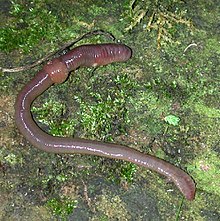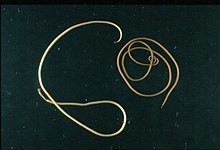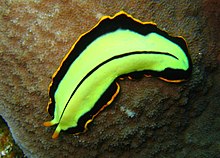Worm


Worms are many different distantly related
Worms vary in size from microscopic to over 1 metre (3.3 ft) in length for marine polychaete worms (bristle worms);[1] 6.7 metres (22 ft) for the African giant earthworm, Microchaetus rappi;[2] and 58 metres (190 ft) for the marine nemertean worm (bootlace worm), Lineus longissimus.[3] Various types of worm occupy a small variety of parasitic niches, living inside the bodies of other animals. Free-living worm species do not live on land but instead live in marine or freshwater environments or underground by burrowing.
In biology, "worm" refers to an obsolete
The term "
History


In taxonomy, "worm" refers to an obsolete grouping,
Informal grouping
In the 13th century, worms were recognized in Europe as part of the category of reptiles that consisted of a miscellany of egg-laying creatures, including "snakes, various fantastic monsters, lizards, assorted amphibians", as recorded by
- . They have a flat, ribbon- or leaf-shaped body with a pair of eyes at the front. Some are parasites.
- tropicalcountries.
- Annelida, consists of the segmented worms, with bodies divided into segments or rings. Among these worms are the earthworms and the bristle worms of the sea.
Familiar worms include the
Worms may also be called
"
Lobopodians are an informal grouping of extinct panarthropods from the Cambrian to the Carboniferous that are often called worms or "worm-like animals" despite having had legs in the form of stubby lobopods. Likewise, the extant Onychophora are sometimes called velvet worms despite possessing stubby legs.
Society and culture
Wyrm was the Old English term for carnivorous reptiles ("serpents") and mythical dragons. "Worm" has also been used as a pejorative epithet to describe a cowardly, weak or pitiable person.
Worms can also be farmed for the production of nutrient-rich vermicompost.
See also
- Sea worm, lists various types of marine worms
- Worm cast
- Worm charming
- Vermeology
- Helminthology
- Nematology
Notes
References
- ^ "Cornwall – Nature – Superstar Worm". BBC. 7 April 2009.
- ^ "Worm Digest - The Mighty Worm". 2 October 2005. Archived from the original on 19 February 2009.;
- ISBN 978-0851126586.
- ^ Linnaeus, Carl (1758). Systema naturae per regna tria naturae: secundum classes, ordines, genera, species, cum characteribus, differentiis, synonymis, locis (in Latin) (10th ed.). Holmiae (Laurentii Salvii). Archived from the original on 10 October 2008. Retrieved 22 September 2008.
- ^ "Espèce de". Reverso Dictionnaire. Retrieved 1 March 2018.
- ISBN 978-0-674-06167-5.
- PMID 19003926.
- ISBN 9780226260709.
